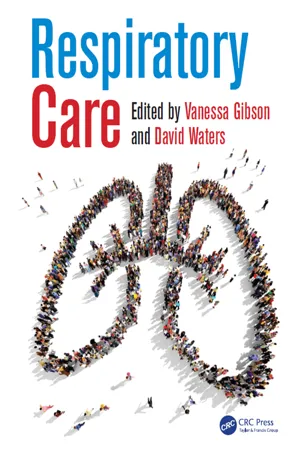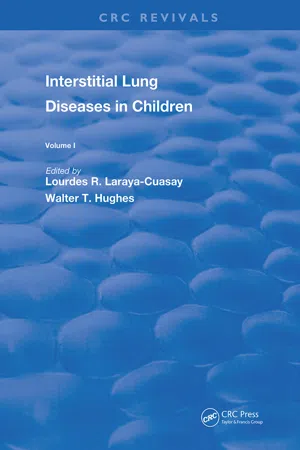Biological Sciences
Bacterial Pneumonia
Bacterial pneumonia is a type of lung infection caused by bacteria, leading to inflammation and fluid accumulation in the air sacs of the lungs. Common symptoms include cough, fever, difficulty breathing, and chest pain. Treatment typically involves antibiotics to target the specific bacteria causing the infection, and in severe cases, hospitalization may be necessary for supportive care.
Written by Perlego with AI-assistance
Related key terms
3 Key excerpts on "Bacterial Pneumonia"
- eBook - ePub
- Vanessa Gibson, David Waters(Authors)
- 2016(Publication Date)
- Routledge(Publisher)
A very simple definition of pneumonia is an infection of the lung tissue (Campbell, 2003). Hansall and Padley (1999) define pneumonia as an inflammation and infection of the terminal bronchioles and alveoli resulting in consolidation. A more comprehensive definition has been developed by Lim et al. (2009) who define pneumonia diagnosed in the community as symptoms of an acute lower respiratory tract illness (cough and at least one other symptom), new focal chest signs on examination, at least one systemic feature such as fever and no other explanation for the illness. A definition of the diagnosis of pneumonia for patients admitted to hospital, however, included signs and symptoms consistent with an acute lower respiratory tract infection associated with new radiographic shadowing for which there is no other explanation and the illness is the primary reason for hospital admission. However, there are a number of different approaches to the classification of pneumonia which include:• Where the pneumonia was contracted, i.e. in the community or in hospital (see later)• In relation to the part of the lung affected, i.e. lobar where one or more lobes are consolidated or bronchial pneumonia where the infection is more widespread and appears as patchy consolidation around the terminal bronchioles• In relation to the causative organism, i.e. bacterial, viral or fungalHowever, there are other types of pneumonia which are often labelled atypical pneumonia and include Legionnaire’s disease; mycoplasma pneumonia; Chlamydia psittaci; Coxiella burnetti; in addition, there is aspiration pneumonia (Mendleson’s Syndrome), HAP/VAP and more recently healthcare-associated pneumonia (Davies and Moores, 2010; Cascini et al., 2013).PATHOPHYSIOLOGYThe delicate walls of the alveoli need to be protected from damage. Davies and Moores (2010) suggest that the respiratory system has evolved to offer protection to the very fine, vascular and moist surface of the alveoli. The upper and conducting airways play a major role in protecting the respiratory surface by filtering out particles and vapours from the air. The anatomy and physiology of the respiratory system is more fully described in Chapter 1 - eBook - ePub
- Lourdes R. Laraya-Cuasay, Walter T. Hughes, Jr.(Authors)
- 2019(Publication Date)
- CRC Press(Publisher)
Chapter 11Bacterial Pneumonia OF INFANTS AND CHILDREN Fred F. BarrettTable of Contents
- I. Introduction
- II. Etiology
- III. Pathogenesis
- IV. Clinical Features
- A. Pneumococcal Pneumonia
- B. Hemophilus Influenzae Pneumonia
- C. Staphylococcal Pneumonia
- D. Miscellaneous Etiologic Agents
- V. Diagnosis
- VI. Radiographic Features
- VII. Treatment
- VIII. Complications
- IX. Course and Prognosis
- References
I. Introduction
Bacterial Pneumonia is an inflammatory process of the lung which may involve interstitial tissue and/or pleura at some point in its evolution but by definition always progresses to alveolar consolidation with inflammatory cells and bacteria.1II. Etiology
Hospitalization for lower respiratory infection has declined in the U.S. in recent years due to a variety of factors including the advent of antibiotics, earlier treatment of respiratory infections, and access to medical care by an increasing proportion of the pediatric population. However, bacterial lower respiratory infection continues to account for a significant number of hospital admissions. In the 3 year period 1982 to 1984, etiologically confirmed Bacterial Pneumonia accounted for 0.2/100 admissions to LeBonheur Children’s Medical Center in Memphis, Tennessee. The frequency of bacteria as etiologic agents of lower respiratory infection varies from 10 to 50% depending upon the method of patient selection, age range of the study population, and the type of diagnostic procedures employed.2 ,3In studies of large pediatric populations employing a wide range of viral and bacteriologic diagnostic techniques, an etiologic agent was established in approximately 50% of patients with lower respiratory infection and bacteria accounted for 10 to 15% of cases.4 Viruses predominate over the entire pediatric age range, but are especially prominent during the first 6 months of life. The highest frequency of Bacterial Pneumonia (10 to 15%) is seen in the age group 6 months through 4 years. In studies in which patients were highly selected and in which invasive diagnostic procedures (needle lung aspirate and thoracentesis) as well as blood cultures were employed, a bacterial diagnosis was established in from 30 to 50% of cases.2 ,3 ,5 , 6 , 7 , 8 , 9 , 10 , 11 , 12 and 13 - eBook - ePub
- Jiri Mestecky, Michael E. Lamm, Pearay L. Ogra, Warren Strober, John Bienenstock, Jerry R. McGhee, Lloyd Mayer, Jiri Mestecky, Michael E. Lamm, Pearay L. Ogra, Warren Strober, John Bienenstock, Jerry R. McGhee, Lloyd Mayer(Authors)
- 2005(Publication Date)
- Academic Press(Publisher)
M. PNEUMONIAEM. pneumoniae is a major cause of community-acquired respiratory illness in children and adults in terms of both clinical severity and numbers affected. M. pneumoniae is often grouped with Chlamydia pneumoniae and Legionella species as bacterial causes of “atypical” community-acquired respiratory infections. However, it is now evident that atypical pneumonia caused by these pathogens cannot be clinically differentiated from pneumonia caused by other community-acquired pathogens. It is important to note that these atypical pathogens do require enhanced methods of detection, beyond routine respiratory and blood culture, for their diagnosis.M. pneumoniae was first strongly linked with clinical disease in the 1960s. It is now known to cause many acute respiratory syndromes in humans, including pharyngitis, tracheobronchitis, reactive airway disease (wheezing), and community-acquired pneumonia (CAP). The incidence of upper respiratory tract illness is likely 10 to 20 times that of pneumonia. In a review of 13 studies of community-acquired pneumonia since 1995 (including both ambulatory and hospitalized children and adults), 23% of the total 6207 patients were diagnosed with M. pneumoniae infection (Gleason, 2002 ). Infections tend to be endemic, with sporadic epidemics at 4- to 7-year intervals with no seasonal preponderance. Outbreaks of M. pneumoniae- related illness are often associated with institutional settings such as military bases, boarding school, and summer camps.Infection is spread from one person to another by respiratory droplets expectorated during coughing, and infection results in clinically apparent disease in the majority of cases. In sharp contrast to many other respiratory infections, the incubation period for M. pneumoniae is 2 to 3 weeks; hence, the course of infection in a specific population (family, institutional setting) may last several weeks. Manifestations of disease generally have a gradual onset and include malaise, cough, fever, sore throat, and headache. Findings on physical examination are mild in most instances, and clinical findings are often less severe than suggested by the patient’s chest x-ray; hence, the term “walking pneumonia” is often used to describe CAP due to M. pneumoniae. Lung biopsies from patients with M. pneumoniae CAP reveal an inflammatory process involving the trachea, bronchioles, and peribronchial tissue, with a monocytic infiltrate coinciding with a luminal exudate of polymorphonuclear leukocytes. Complications linked with M. pneumoniae
Learn about this page
Index pages curate the most relevant extracts from our library of academic textbooks. They’ve been created using an in-house natural language model (NLM), each adding context and meaning to key research topics.


